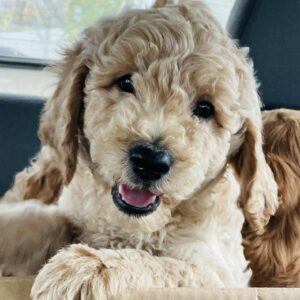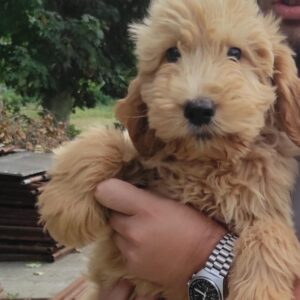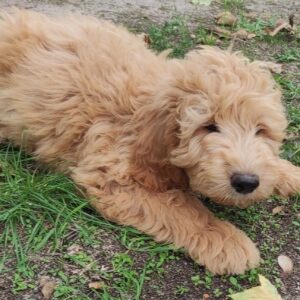
Goldendoodle
Originally created by crossbreeding Golden Retrievers with Poodles, the Goldendoodle comes in three sizes: Miniature, Small Standard, and Large Standard. The soft coat of the Goldendoodle can be wavy, straight, or curly. Most Goldendoodles are considered hypoallergenic, as they shed very little. The Goldendoodle was created with the aim of breeding a dog that was athletic, kind, and easy to train. Friendly and reliable, the Goldendoodle is an intelligent and highly trainable dog, and have been successfully used as guide dogs, therapy dogs, and assistance dogs.
Goldendoodle breed attributes
About Goldendoodle breed
Description
Originally created by crossbreeding Golden Retrievers with Poodles, the Goldendoodle comes in three sizes: Miniature, Small Standard, and Large Standard. They are not typically bred for show conformation but for their temperament, so Goldendoodles don’t have a very uniform appearance. Goldendoodles may be first generation (F1) crosses between a Poodle and Golden retriever; F2 crosses between two first generation dogs; F3, where two F2 dogs are mixed; and multi-generation, which are bred from F3 dogs.
Goldendoodles are typically a little longer than they are tall, which is typical for dogs with good endurance. Their legs are straight and as long as their body is deep. They aren’t overly muscular or bony, but are still hardy and athletic. The Goldendoodle’s topline is level, and the tail is fairly high-set and feathery. The Goldendoodle’s muzzle is typically square and straight. Their eyes are oval shaped and wideset, their ears are floppy and reach down to just below the lower jaw.
Origin: USA
Look
The soft coat of the Goldendoodle can be wavy, straight, or curly. Most Goldendoodles are considered hypoallergenic, as they shed very little; however, the hypoallergenic nature of the coat depends on the individual dog and the nature of your allergies. The Goldendoodle comes in many colours. Almost all coat colours are accepted, barring those associated with health problems, such as double Merles and double dilutes.
Health
While generally a healthy and long-lived breed, the Goldendoodle can suffer from one or more of the following health issues:
- Allergies
- Bloat (Gastric dilation volvulus)
- Ear infections
- Elbow dysplasia
- Hip dysplasia
- Hypothyroidism
- Patellar luxation
- Progressive Retinal Atrophy
- Von Willebrand’s Disease
At Newdoggy.com, we recommend that you buy your dog from reputable breeders, who use genetic testing and good breeding practices to remove genetic conditions from their breeding lines.
Learning
The Goldendoodle was created with the aim of breeding a dog that was athletic, kind, and easy to train. As such, the Goldendoodle is an intelligent and highly trainable dog, and have been successfully used as guide dogs, therapy dogs, and assistance dogs. They are even considered to be more trainable than their progenitors, the Golden Retriever and the Poodle. If you are sure to socialise your Goldendoodle puppy properly, he/she will impress you with his/her intelligence and eagerness to learn.
Temperament
A typical Goldendoodle is friendly and reliable. As they are often used as assistance dogs, it is important for them to be calm and even-tempered. Without proper socialisation, Goldendoodles can be nervous or skittish, so be sure to expose your Goldendoodle puppy to a wide variety of people and places: this will help your puppy to become calm and confident.
Living with
The Goldendoodle is a very adaptable breed. They are very forgiving, which makes them ideal for first-time dog owners. Goldendoodles are great with children, but also get on well with other dogs and pets. They are energetic, so do not get a Goldendoodle unless you are willing to exercise and play with them.
Find Goldendoodle Puppies for Sale
New litter alert
Please fill in the below form and we will let you know when a new Goldendoodle litter arrives.





















